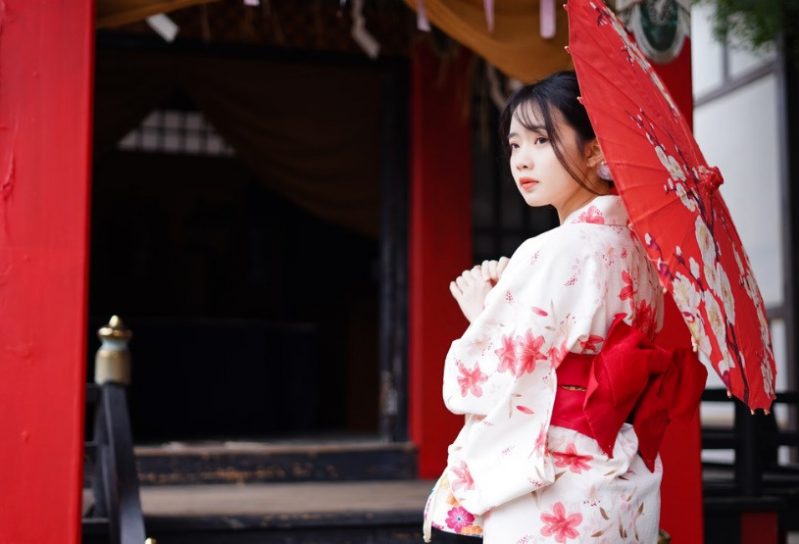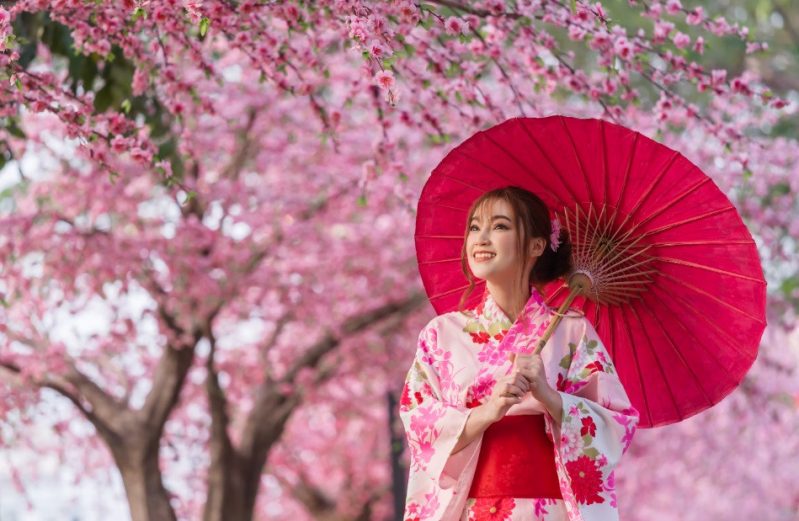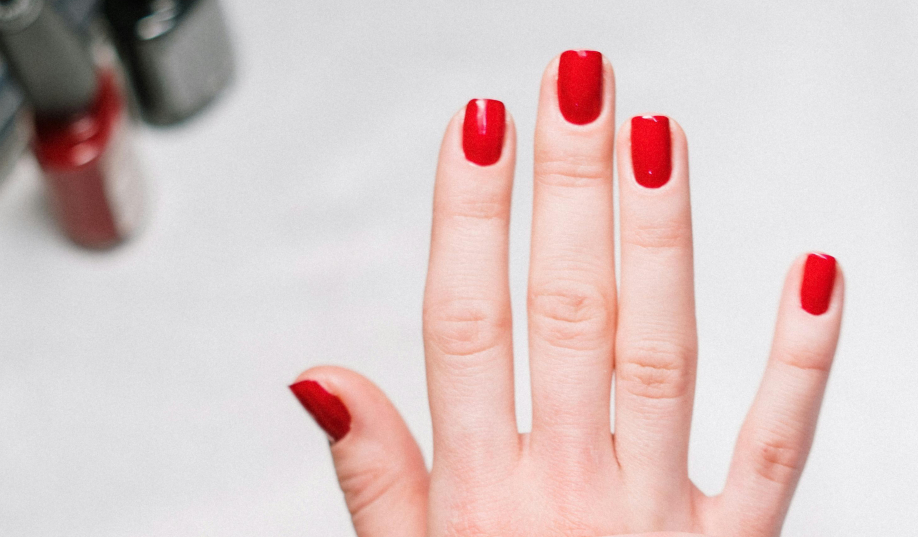Everything You Need to Know About the Japanese Kimono

© Lyu JackSon / Unsplash
For ages, the kimono has been the cornerstone of the Japanese style.
It is not just about clothing. It is a window into Japan’s rich culture and artistic flair. With its history, beauty, and deep symbolism, the kimono shows us how fashion can tell stories and reflect traditions in ways that go beyond what we wear.
Its intricate designs, flowing fabrics, and timeless silhouette have captivated the world for centuries. From formal ceremonies to everyday wear, the kimono holds a special place in Japanese society. But, where does the Japanese kimono even come from and how did it become such a staple in today’s society?
What Is the Japanese Kimono?
The kimono, derived from the Japanese words ki (wear) and mono (thing), is a traditional garment that holds cultural significance in Japan. It is crafted in a “T” shape from four single pieces of fabric known as tans, which are meticulously hand-sewn together. Kimonos vary widely in style and pattern, showcasing intricate designs and often vibrant colors. They are typically secured with an obi, a sash, or a belt, which adds to the overall elegance and structure of the attire.

What Does It Symbolize?
The kimono holds deep cultural symbolism in Japan, representing tradition, status, and aesthetics:
- Tradition and Heritage: The kimono embodies Japan’s rich cultural heritage, reflecting centuries-old craftsmanship and design.
- Status and Formality: The style, fabric, and accessories of a kimono can signify the wearer’s social status, rank, and the formality of the occasion.
- Beauty and Elegance: Kimonos are admired for their intricate patterns, vibrant colors, and graceful silhouette, symbolizing beauty and elegance.
- Seasons and Nature: Traditional kimono designs often incorporate motifs inspired by nature, reflecting seasonal changes and the natural world.
- Respect and Etiquette: Wearing the appropriate kimono for specific occasions demonstrates respect for customs and traditions, conveying gratitude and honor.
The History of the Kimono
During Japan’s Heian Period (794-1185), garments similar to the modern kimono began to take shape. Originally, these garments were worn alongside hakama, which are long skirts or trousers, and apron-like garments called mo. Over time, the fashion shifted towards wearing the kimono-style robe without hakama.
This change necessitated the development of the obi, a wide sash worn around the waist to securely fasten the robe closed. Thus, the evolution of the kimono not only reflected changes in fashion but also marked the introduction of the obi as an essential component of traditional Japanese attire.

During the Kamakura Period (1185-1333), the kimono became a popular everyday garment in Japan, marking the beginning of layering as a fashion trend. This period also saw the experimentation with traditional Japanese color combinations, influenced by seasons, gender, and sometimes political and family affiliations.
By the Edo Period (1603-1868), kimono-making had evolved into a specialized craft, producing kimonos that were not only functional but also works of art. Some kimonos were highly valuable, costing more than a family home, and became cherished heirlooms passed down through generations.

Caring for a Kimono
Traditional kimono washing involved a meticulous process of dismantling the garment into individual pieces for cleaning (toki arai), followed by stretching and drying each piece on boards after washing and starching (arai hari). Due to this method, kimono traditionally required hand-sewing after washing, making the process costly and challenging. While modern fabrics and cleaning techniques have reduced the necessity for this intensive washing process, traditional methods are still preserved, particularly for high-end kimonos.

New custom-made kimono are typically delivered to customers with long, loose basting stitches along the outer edges, known as shitsuke ito. These stitches prevent bunching, folding, and wrinkling, ensuring the kimono’s layers remain aligned. They are often replaced during storage to maintain the garment’s pristine condition.
What About Folding?
Folding kimono follows specific methods to preserve the garment and prevent creasing during storage. They are often stored wrapped in acid-free paper envelopes called tatōshi to further protect them.
Kimono should be aired out seasonally and before and after each wear. Many opt for dry cleaning to maintain them, which, while costly, is often more economical than traditional dismantling for cleaning. However, certain fabrics or dyes may prohibit this method.
Why Are They So Popular?
Kimonos gained popularity for their versatility, allowing for easy layering and adaptation to different seasons. Heavy silk kimonos were favored in fall and winter, while lighter linen and cotton yukata became popular for summer wear. Yukata are still widely worn during seasonal events like summer festivals and fireworks displays (miyabi).

Since the Edo Period, men’s and women’s kimono fashions have remained largely unchanged. However, the elaborate process of wearing kimonos and the cumbersome sandals eventually became impractical. During the Meiji Period (1868-1912), the kimono declined in popularity as the government promoted Western clothing styles, marking a significant shift in Japanese fashion trends.
Interesting Facts You Need to Know
Generational “Wealth”
Kimonos are often heirloom pieces passed down through generations, known for their high cost due to materials like silk and linen and meticulous hand-finishing of seams. While traditional kimonos can be very expensive, particularly for special occasions, informal cotton versions called yukata are now widely available across Japan as more affordable alternatives.

More Than Just Fashion
In Japan, they are not just fashion statements but symbols of etiquette and respect. They signify the formality and importance of occasions, with designs, colors, and obi knots reflecting rank and status. It is customary to wear the left side of the kimono over the right. This is except in the case of dressing a deceased person for burial. This tradition underscores the cultural significance of kimono-wearing in Japan.
Japanese Kimonos Today
Kimonos, deeply rooted in Japanese tradition, have gained popularity as a cult fashion item globally. Starting in the late 1990s, there was a resurgence of interest in Japanese culture worldwide. The kimono’s intricate patterns, vibrant colors, and distinctive silhouette captivated a fashion-conscious audience eager to express individuality, particularly on platforms like social media.

For many, wearing a kimono provides a departure from everyday attire, offering a connection to history and a chance to dress up. Others are drawn to its beauty and femininity, viewing it as a unique alternative to mainstream designer dresses. Despite not having visited Japan, modern enthusiasts often choose kimonos for their special occasions.
In Japan, the rise of kimono rental shops indicates a growing interest in rediscovering this traditional garment, traditionally worn for formal events like weddings. Young designers are revitalizing kimono styles and patterns, suggesting that kimonos can also find a place in everyday wardrobes.
What do you think of the Japanese kimono? Would you ever wear one?
You might also want to read: 15 Things You Should NOT Do in Japan


